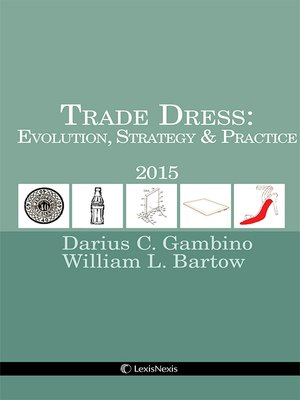
Sign up to save your library
With an OverDrive account, you can save your favorite libraries for at-a-glance information about availability. Find out more about OverDrive accounts.
Find this title in Libby, the library reading app by OverDrive.



Search for a digital library with this title
Title found at these libraries:
| Library Name | Distance |
|---|---|
| Loading... |
Trade Dress: Evolution, Strategy and Practice, 2015 Edition, by Darius C. Gambino & William L. Bartow: While the concept of trade dress has existed for some time, the doctrine remained dormant for many years until the Supreme Court decisions in Two Pesos, Wal-Mart and TrafFix Devices. These decisions raised the profile of trade dress, and changed its perception for many practitioners. Ultimately, these decisions increased attention to trade dress at the developmental stage. As with patents, many companies have implemented programs to identify and protect trade dress as early as possible, especially in the wake of these decisions. There is no doubt that trade dress litigation will soon not only become a major competitor to patent litigation as a means of resolving disputes, but in most instances, a significantly cheaper and viable alternative.
Trade Dress: Evolution, Strategy, and Practice analyzes the differences between the two major types of trade dress - product configuration and product packaging - describes the standards of proof for each, and explains how these standards have been interpreted (and in some cases misinterpreted) by the federal courts. The book also reviews the evolution of trade dress in the United States and its recent emergence as an enforcement alternative. Finally, it offers practical suggestions on how best to utilize trade dress rights in protecting a client's intellectual property.
Features
Reviews
"Darius C. Gambino and William L. Bartow have written a book about the rather complicated subject of trade dress that even I, an industrial designer with degrees only in fine arts, can understand. They accomplished this without 'dumbing down' the contents. The authors explain, for example, the critical choice that must be made between product packaging trade dress and product configuration trade dress, in crystal clear language. By claiming the trade dress of a car body as a package rather than as a configuration, you eliminate the need to prove acquired distinctiveness (secondary meaning), and note that in many cases the failure to make such proof can sink your trade dress infringement case before you ever get to an assessment of likelihood of confusion. This is but one of many examples they cite that, in my experience, are not well understood by attorneys." — Cooper Woodring, Industrial Designer and Fellow of the Industrial Designers Society of America (From the Foreword)
The eBook versions of this title feature links to Lexis Advance for further legal research options.







